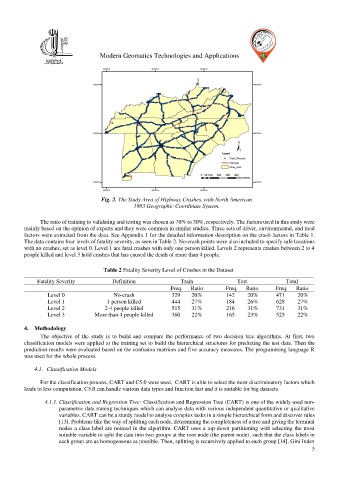Page 605 - NGTU_paper_withoutVideo
P. 605
Modern Geomatics Technologies and Applications
Fig. 2. The Study Area of Highway Crashes, with North American
1983 Geographic Coordinate System.
The ratio of training to validating and testing was chosen as 70% to 30%, respectively. The factors used in this study were
mainly based on the opinion of experts and they were common in similar studies. Three sets of driver, environmental, and road
factors were extracted from the data. See Appendix 1 for the detailed information description on the crash factors in Table 1.
The data contains four levels of fatality severity, as seen in Table 2. No-crash points were also included to specify safe locations
with no crashes, set as level 0. Level 1 are fatal crashes with only one person killed. Levels 2 represents crashes between 2 to 4
people killed and level 3 hold crashes that has caused the death of more than 4 people.
Table 2 Fatality Severity Level of Crashes in the Dataset
Fatality Severity Definition Train Test Total
Freq. Ratio Freq. Ratio Freq. Ratio
Level 0 No-crash 329 20% 142 20% 471 20%
Level 1 1 person killed 444 27% 184 26% 628 27%
Level 2 2-4 people killed 515 31% 216 31% 731 31%
Level 3 More than 4 people killed 360 22% 165 23% 525 22%
4. Methodology
The objective of the study is to build and compare the performance of two decision tree algorithms. At first, two
classification models were applied to the training set to build the hierarchical structures for predicting the test data. Then the
prediction results were evaluated based on the confusion matrices and five accuracy measures. The programming language R
was used for the whole process.
4.1. Classification Models
For the classification process, CART and C5.0 were used. CART is able to select the most discriminatory factors which
leads to less computation. C5.0 can handle various data types and function fast and it is suitable for big datasets.
4.1.1. Classification and Regression Tree: Classification and Regression Tree (CART) is one of the widely used non-
parametric data mining techniques which can analyse data with various independent quantitative or qualitative
variables. CART can be a sturdy model to analyse complex tasks in a simple hierarchical form and discover rules
[13]. Problems like the way of splitting each node, determining the completeness of a tree and giving the terminal
nodes a class label are noticed in the algorithm. CART uses a top-down partitioning with selecting the most
suitable variable to split the data into two groups at the root node (the parent node), such that the class labels in
each group are as homogeneous as possible. Then, splitting is recursively applied to each group [14]. Gini Index
3

